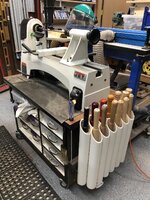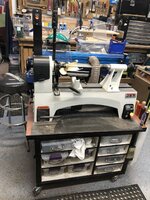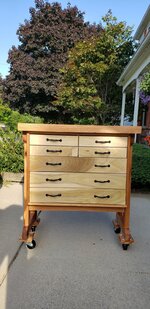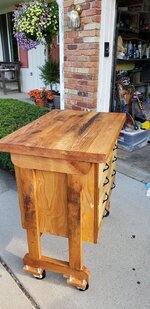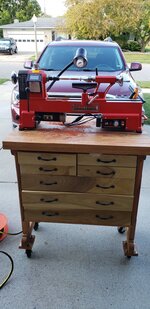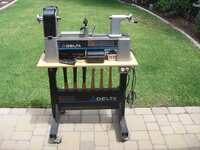JonathanF1968
Member
Hello all,
I moved recently, and have been thinking about my new shop and how it's going to be so much better than my old shop.... Many considerations, but the item for your consideration at the moment is lathe stands.
I use a Delta Mini Lathe with an extension bed.
My new philosophical ideal is that I want as much on wheels as possible. Does anyone have their lathe on wheels? I'd like to see a picture, and receive any insights.
I'm thinking, the qualities of a good lathe stand are:
1. Stability, obviously. And in this case, moveability, which is potentially at odds with stability.
2. Holds turning tools and chucks. I have perhaps thirty chisels, etc., and use about five of them all the time. Some of them are long-handled types.
3. Holds safety gear and other related tools, such as a hatchet that I seem to use surprisingly often when turning.
4. Holds a few finishes, adhesives, etc., but this could be a dark road to go down, as there are potentially an infinite number of them. Most might be better off in a cupboard.
5. Holds pen kits. Again, maybe better off in a cupboard. Similar to wood. It could be a dark path.
6. Dust/shavings collection support, which I haven't figured out yet.
Looking forward to your thoughts and particularly your photos. I previously had my lathe on a workbench, which was stable but not very convenient, in the grand circus of the shop's workings. The overall concept is to have a central "dance floor" where machines on wheels come and go, based on the project at hand. Could be a lathe, or forge, or welding table, or table saw, or drill press, etc.
--Jonathan
I moved recently, and have been thinking about my new shop and how it's going to be so much better than my old shop.... Many considerations, but the item for your consideration at the moment is lathe stands.
I use a Delta Mini Lathe with an extension bed.
My new philosophical ideal is that I want as much on wheels as possible. Does anyone have their lathe on wheels? I'd like to see a picture, and receive any insights.
I'm thinking, the qualities of a good lathe stand are:
1. Stability, obviously. And in this case, moveability, which is potentially at odds with stability.
2. Holds turning tools and chucks. I have perhaps thirty chisels, etc., and use about five of them all the time. Some of them are long-handled types.
3. Holds safety gear and other related tools, such as a hatchet that I seem to use surprisingly often when turning.
4. Holds a few finishes, adhesives, etc., but this could be a dark road to go down, as there are potentially an infinite number of them. Most might be better off in a cupboard.
5. Holds pen kits. Again, maybe better off in a cupboard. Similar to wood. It could be a dark path.
6. Dust/shavings collection support, which I haven't figured out yet.
Looking forward to your thoughts and particularly your photos. I previously had my lathe on a workbench, which was stable but not very convenient, in the grand circus of the shop's workings. The overall concept is to have a central "dance floor" where machines on wheels come and go, based on the project at hand. Could be a lathe, or forge, or welding table, or table saw, or drill press, etc.
--Jonathan

